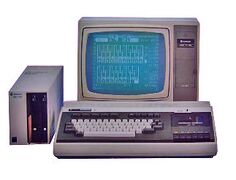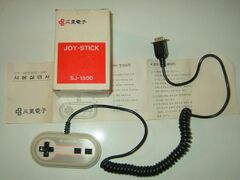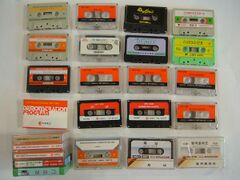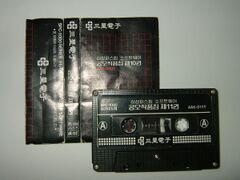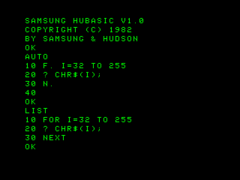Engineering:SPC-1000
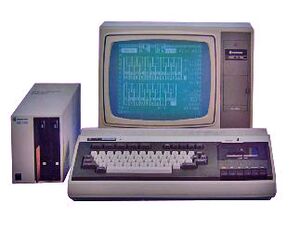 | |
| Developer | Samsung, Hudson Soft |
|---|---|
| Manufacturer | Samsung |
| Generation | First |
| Release date | 1983 |
| Introductory price | 495,000 Won compared to $398.68 USD [1] |
| Discontinued | 1986 |
| Operating system | HuBASIC, CP/M |
| CPU | Z80-A @ 4 MHz |
| Memory | 64KB |
| Storage | tape, floppy discs |
| Display | 128 x 192 in 4 colors, and 256 x 192 in 2 colors, semigraphics in 9 colors |
| Graphics | AMI S68047 |
| Sound | General Instrument AY-3-8910 (3 voices, 8 octaves) |
| Input | Keyboard |
| Controller input | Gamepad |
| Connectivity | 34-pin expansion bus, joystick port, centronics printer port, NTSC video out, RF connection |
| Power | 110V/220V |
| Dimensions | 48 x 27.5 x 9.5 cm |
The SPC-1000 is a Z80-based personal computer produced by Samsung. It was the first computer created by the brand.[2] Developed in South Korea , it features built-in HuBASIC BASIC written by Hudson Soft in Japan.[3] The computer features a 4 MHz processor and 64 KB of RAM.
History
Launched in 1983, the SPC-1000 was the first personal computer produced by Samsung.[4] The machine was mainly used in education.[5]
Description
The main unit included the keyboard and a built-in tape recorder. External disk drives, a gamepad, and a dedicated CRT monitor[5] could be connected to this unit. It shipped with a user manual on how to use the computer. The computer was capable of running CP/M if equipped with double-side, double density floppy disk drives.
Software was available on cassette tapes, with more than one hundred titles released, between games and programs.[6] Some games were conversions of popular Arcade games in the early 1980s, but adapted to the computer limitations.[7][8]
Features
The computer uses a Zilog Z80 CPU running at 4 MHz,[3] and offers 64KB of RAM. Sounds is produced by a General Instrument AY-3-8910 chip, providing 3 voices with 8 octaves each.[3] Video is generated by an AMI S68047 chip (quite similar to the Motorola 6847[9]), offering semigraphics in 9 colors, a 128 x 192 mode in 4 colors, or a 256 x 192 mode in 2 colors.[3][10]
Gallery
References
- ↑ 495,000 won to usd - Google Search. Retrieved 16 January 2023.
- ↑ "SPC-1000, the first computer made by Samsung - Samsung Company". https://artsandculture.google.com/asset/spc-1000-the-first-computer-made-by-samsung-samsung-company/4QFdchYpiF0rcQ.
- ↑ 3.0 3.1 3.2 3.3 "SPC-1000". www.old-computers.com. https://www.old-computers.com/museum/computer.asp?c=803. Retrieved 7 January 2016.
- ↑ "You're How Old?! Samsung PCs Modern History". Samsung. 19 December 2011. http://news.samsung.com/global/youre-how-old-samsung-pcs-modern-history. Retrieved 6 January 2016.
- ↑ 5.0 5.1 "Samsung's first PC up for auction". 20 October 2017. https://www.koreatimes.co.kr/www/tech/2021/09/133_238005.html.
- ↑ "Software List: Samsung SPC-1000 cassettes (spc1000_cass)". https://arcade.vastheman.com/minimaws/softwarelist/spc1000_cass.
- ↑ "Hardcore Gaming 101: A History of Korean Gaming". http://www.hardcoregaming101.net/korea/part1/company-samsung.htm.
- ↑ "Hardcore Gaming 101: History of Korean Gaming". http://www.hardcoregaming101.net/korea/part1/company-samsung2.htm.
- ↑ "MC6847 vs S68047: 정리" (in en-US). http://retrospc.blogspot.com/2010/01/mc6847-vs-s68047-%EC%A0%95%EB%A6%AC.html.
- ↑ "Datasheet Archive S68047 datasheet download". https://www.datasheetarchive.com/pdf/download.php?id=b77b48ca32c16e2b21d91ef58373cecf6fa514&type=O&term=S68047.
| Wikimedia Commons has media related to SPC-1000. |
 |
